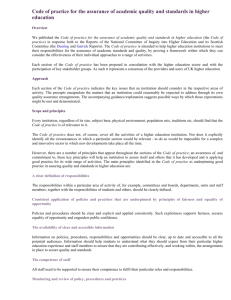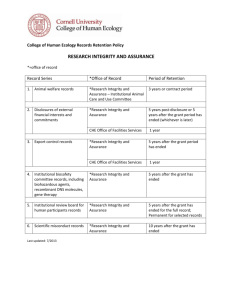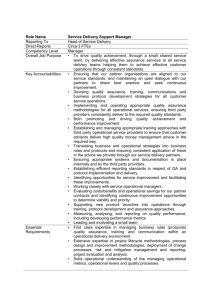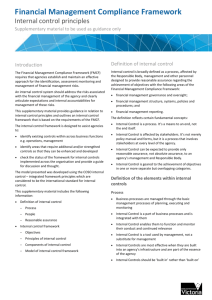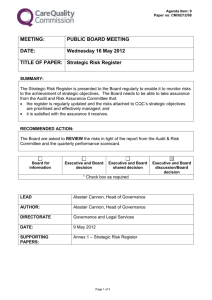Agenda Item: 11 Paper No: CM/02/12/10 MEETING: PUBLIC
advertisement
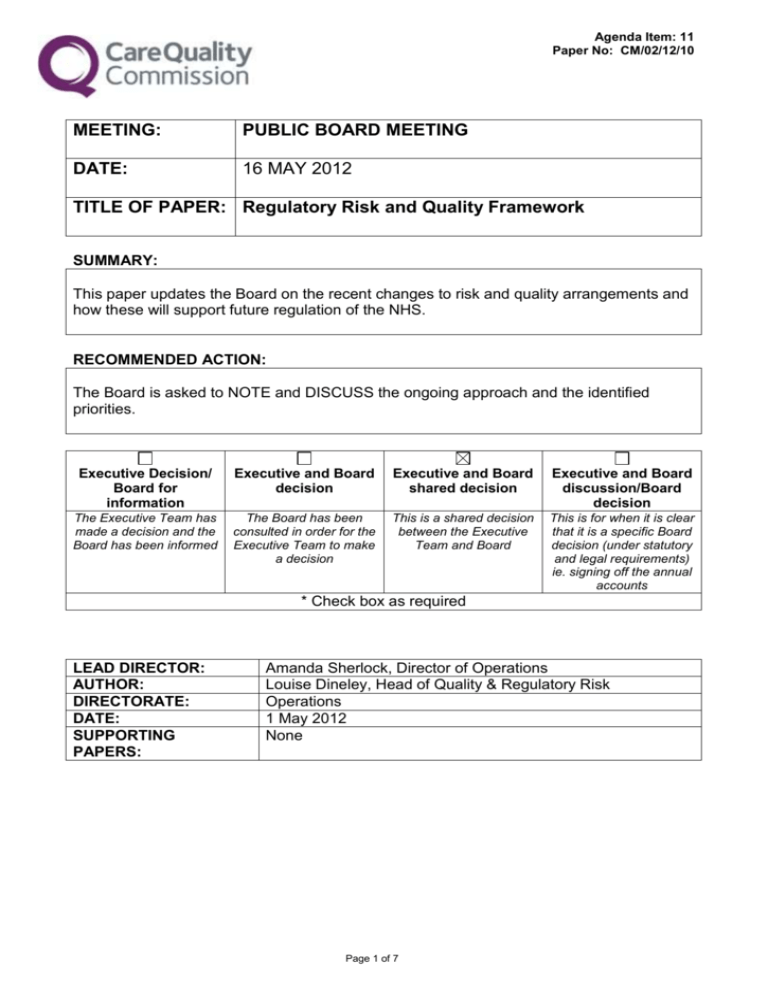
Agenda Item: 11 Paper No: CM/02/12/10 MEETING: PUBLIC BOARD MEETING DATE: 16 MAY 2012 TITLE OF PAPER: Regulatory Risk and Quality Framework SUMMARY: This paper updates the Board on the recent changes to risk and quality arrangements and how these will support future regulation of the NHS. RECOMMENDED ACTION: The Board is asked to NOTE and DISCUSS the ongoing approach and the identified priorities. Executive Decision/ Board for information Executive and Board decision Executive and Board shared decision Executive and Board discussion/Board decision The Executive Team has made a decision and the Board has been informed The Board has been consulted in order for the Executive Team to make a decision This is a shared decision between the Executive Team and Board This is for when it is clear that it is a specific Board decision (under statutory and legal requirements) ie. signing off the annual accounts * Check box as required LEAD DIRECTOR: AUTHOR: DIRECTORATE: DATE: SUPPORTING PAPERS: Amanda Sherlock, Director of Operations Louise Dineley, Head of Quality & Regulatory Risk Operations 1 May 2012 None Page 1 of 7 Agenda Item: 11 Paper No: CM/02/12/10 GOVERNANCE AUDIT TRAIL: This paper was commissioned as a supporting paper to the paper in relation to the Regulation of the NHS 2 years on, which was received by the Board on 18 April 2012. LINK TO STRATEGIC OBJECTIVES AND BUSINESS PLAN The review and strengthening of Risk and Quality arrangements will enable us to focus our regulation more effectively going forward, and deliver better regulation for people. There is direct relationship to the recommendations contained in the DH Capability Review as they relate to understanding the impact of the generic regulatory model and understanding of risk in the system. IMPLICATIONS FOR NCSC None directly FINANCIAL IMPACT: Potential resource implications depending on direction given. RISK IMPACT: The successful management of regulatory risk and quality issues arising from regulation is a key issue which carries significant reputational risk for the CQC. REPUTATION IMPACT: All of CQC’s operations and regulatory activity carries reputational risk for the CQC. LEGAL IMPLICATIONS: The parameters under which we regulate all sectors are determined by the regulations and we need to ensure that these are not only met but as a regulator all our actions are timely and proportionate. HEALTHWATCH IMPACT: None directly EQUALITY IMPACT ASSESSMENT: Not required Page 2 of 7 Agenda Item: 11 Paper No: CM/02/12/10 1. Introduction 1.1 This paper has been produced to provide Board members with an update on the operational changes made to strengthen Risk and Quality arrangements and processes. The paper also identifies a commitment to measure success through the effectiveness of regulatory action in addressing poor performance as well as the performance of internal systems as providing the levers for change. 1.2 The report specifically focuses on management, assurance and governance systems. Actions being taken to further test and develop the regulatory model, including training for staff, will be covered, and reported to the Boar, via the Scrutiny Review. 2. Background 2.1. Over the last six months, the Operations Directorate has reviewed the current arrangements for the identification and management of regulatory risk as part of its ongoing programme of continual improvement to strengthen the management of risk, as well as consistency in the application of the regulatory model. At the same time this work has reviewed and developed internal assurance, regulatory judgements and the effective regulation of registered providers. 2.2 Regulatory quality and assurance tools should assist CQC in assessing the effectiveness of action taken both in terms of outcomes and also tools used to lever the required change by providers. Revised reporting has commenced to the Audit and Risk Assurance Committee on the themes and trends of regulatory risk and this work will continue to evolve with the support of the committee. For example, assurance on the consistency surrounding regulatory judgements as well as consistent application of the regulatory model across all regional compliance teams. 2.3 Key issues to address through the Risk and Quality Framework and revised arrangements include: 2.4 Consistency in the application of the regulatory model to all sectors Consistent use of evidence of non compliance in taking timely and proportionate action including the use of the full range of enforcement powers. Innovative use of the Commission’s enforcement powers to avoid adding to the impact of poor quality Perceived tolerance of non compliance and concerns relating to care delivery through assurance and action Robust rationale to judgements at all stages of the process as well as action taken to support transparency and a focus on factual accuracy through provider challenge. Effective reporting and assurance through the Risk and Escalation Committee and Audit and Risk Assurance Committee. In addition to these common issues, there are also a number of specific challenges in regulating the NHS: Legislative constraints, for example time frames for representation before the regulator can put information of its concerns about a service into the public domain. Page 3 of 7 Agenda Item: 11 Paper No: CM/02/12/10 2.5 The reality of quickly closing down key front line services such as A&E and maternity. Assessing the level of risk to the general public and the threshold for taking urgent actions: ‘how bad does a service have to be before it’s closed?’ Influencing commissioner behaviour and patient choice. Enhanced Regulatory Quality & Risk The move to “Four Regions” , has provided an opportunity to strengthen the management and assurance arrangements for regulatory risk and quality. Figure 1 details the reporting arrangements. Figure 1: Operations Risk & Quality Structure – April 2012 Head of Regulatory Risk and Quality Senior Risk Manager Regulatory Risk and Quality Officer Senior Quality Manager Regulatory Risk and Quality Officer Specialist Areas: IR(ME)R, Pharmacy &Controlled Drugs Regulatory Risk and Quality Officer Enforcement Advisor x 2 (North & Central, London & South) National Advisor: Safeguarding x 1 HCAI &Risk x 1 Corporate Provider Compliance Manager (Team Leader) Quality, Assurance & Risk Manager x5 (Lon, Central, North, South, NCSC) Corporate Provider Compliance Inspector x4 Key changes and developments include: Establishing two lead roles – Quality Manager and Risk Manager to lead on the development and implementation of a Quality and Risk Framework. The framework will provide for the consistent management, assessment and reporting of risk and assurance of the response to non compliance and corresponding regulatory action. The framework also provides a structure to challenge the quality of regulatory actions from registration through to judgements, report publication and the effectiveness of action taken in addressing the impact of poor standards of care. Development of a Quality and Risk Manager role to include an assurance function. Line management of this role has also transferred to a central operations function to strengthen independent and constructive challenge of regulatory decision making by regional compliance teams. Refocus on Corporate Provider Compliance through the establishment of a corporate compliance team. The team will provide strategic oversight to the performance and compliance of corporate providers to assist in the identification of Page 4 of 7 Agenda Item: 11 Paper No: CM/02/12/10 risks relating to the quality and safety of service provision. This provides the opportunity to horizon scan and proactively address emerging themes of non compliance either with a provider or through sector led improvements; consider systemic issues of a corporate provider as a whole rather than through repetitive location based activity as well as focus the attention of regional regulatory activity to areas of risk. Enforcement Advice has been enhanced with two dedicated roles supporting the regions risk panels, enabling regions to pursue enforcement action in a timely manner and streamline enforcement processes. Regulatory Risk and Quality Officer resource has also increased to strengthen the interface with Operations Intelligence and the operational use of intelligence and information collated from the myriad of data sources. For risk this will support the work of identifying themes and trends in non compliance and regulatory activity as well as the deployment of resources whilst for quality this role will be essential to the oversight of risk across corporate providers. 2.6 The strengthening of the central resource will support the translation of the national agenda and priorities relating to risk and quality at a regional level, improving elements such as: Functionality of regional risk and quality boards Increased consistency in the application of the regulatory model across all regulated sectors Clear rationale for regulatory action and the use of regulatory powers selected Timely and proportionate enforcement action in response to the identified impact on service users Use of intelligence and emerging themes and trends to help target inspection activity Oversight of the compliance of corporate providers and potential systemic issues will help focus inspection action and ensure a proportionate response through either location specific or provider level action 2.7 Figure 2 details a proposed model combining reporting and assurance responsibilities and strengthened governance arrangements for Regulatory Risk and Quality. The revised Risk & Quality Boards will provide a critical function in the development of the assurance function at a team, regional and national level. A pivotal group, the regional board will seek assurance on the effective application of the regulatory model (through activity and action) as well as promoting the accountabilities of Heads of Regional Compliance, Compliance Managers and Compliance Inspectors in the management of risk and quality issues. 2.9 In addition to the key functions of the model at a regional level, the model also offers a strategic oversight on the management of regulatory risk and quality standards in relation to the application of the regulatory model. The Risk and Escalation Committee and Audit and Risk Assurance Committees will receive a strategic oversight of regulatory risk in the context of identified or emerging themes and trends of non compliance, deployment of resources, use of regulatory powers. Unlike the current arrangements the committee structures will move away from the operational detail which regions will be accountable for and move towards what does the information tell the CQC on regulatory performance, areas of highest risk Page 5 of 7 Agenda Item: 11 Paper No: CM/02/12/10 and the assurance available in the management of these risks or the effectiveness of the model. Figure 2: Regulatory Risk and Quality Governance Arrangements – Proposed Model Escalation of risks with Regions maintaining oversight and responsibility for regulatory decisions whilst the supporting governance structure (eg REC and ARAC) seek further assurance on the model, strategic management of risk and resource deployment Audit & Risk Assurance Committee Feedback of identified themes and trends as well as potential areas of focus inspections or operational improvements Risk & Escalation Committee Regional Risk & Quality Board Sub Region Risk & Quality Panel Compliance Manager / Team Risk Register Compliance Inspector Portfolios 2.9 Enhancing Regulation of Individual Sectors In addition to the improvements that the revised structure for risk and quality offer internal systems and regional frontline arrangements, the changes also develop the Commission’s regulation of individual sectors. 2.9.1 NHS The refocus of the risk panels supports tighter regulation of providers of persistent non compliance or struggling performance as well as considering the quality of regulatory decisions from registration to enforcement through to publication. Over the next 2 years, there will need to be a specific focus on the remaining NHS Trusts in the Foundation Trust pipeline. Aligned to routine regulatory activity, a dedicated “assurance team” consisting of four compliance managers will work will regional teams to ensure that the regulatory actions, decisions and judgements associated with aspiring Foundation Trusts are robust. In addition this team will work closely with Monitor, the DH and other stakeholders to identify, manage (within the CQC’s powers) and escalate the risks as appropriate, of Trusts that fail to become Foundation Trusts. The CQC’s role within this process will be to regulate services in line with the required standards for quality and safety care. 2.9.2 Adult Social Care and Independent Healthcare Over the last 12 months there have been a number of examples where the scrutiny of corporate providers has been required for example Southern Cross and Castlebeck as two examples. The establishment of a Corporate Provider compliance team provides the opportunity for the regular review and oversight of patterns of compliance and non compliance, consideration of other factors such as Page 6 of 7 Agenda Item: 11 Paper No: CM/02/12/10 market behaviours - commissioning patterns and funding and for information to be used proactively in focussing the remit of inspections as well as feeding emerging themes into provider groups for engagement in sector led improvement. 2.10 Measures of Success Key measures of success of the structure, its implementation and the differences that it makes to regulation have been identified. These measures will exist at a Directorate level as well as a macro indicator on the corporate score card. The corporate scorecard currently identifies a number of risk and quality indicators which measure performance of stages of the regulatory process. Additional indicators have been identified, the data definitions and data collection needs to be finalised; these include: Regional Metrics Number of location / providers identified as non compliant / compliant Number of locations / providers where the regulatory action proposed to the Management Review Meeting is pursued Percentage of location / providers where the CQC’s first regulatory intervention is successful in achieving compliance Directorate Metrics All regions (inc Operational Improvement & Planning) have operational risk and quality boards meeting on a monthly basis Proportion of locations / providers whose services are identified through the judgement framework as having a major, moderate or minor impact on service users Distribution of enforcement action by sector and by outcome Corporate Metrics Distribution and effectiveness of enforcement action across sectors and in addressing non compliance Correlation of inspection activity against themes and trends identified across available information sources 3. Next Steps 3.1 The Board are asked to agree the model 3.2 To embed the structure through the completion of recruitment and the delivery of the identified key priorities at three, six and twelve months milestones. Name: Title: Date Louise Dineley Head of Regulatory Risk & Quality 1 May 2012 Page 7 of 7




